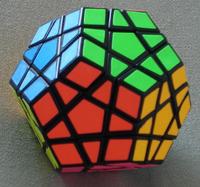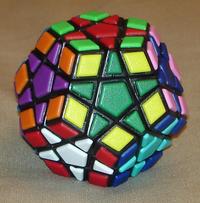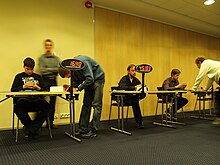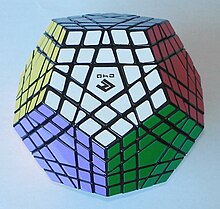| Revision as of 17:21, 10 April 2017 editTkwikihelper (talk | contribs)280 edits Records (Top 5s)← Previous edit | Revision as of 17:22, 10 April 2017 edit undoTkwikihelper (talk | contribs)280 editsm typoNext edit → | ||
| Line 37: | Line 37: | ||
| == Records == | == Records == | ||
| ] completing Megaminxes at the Estonian Open 2011.]] | ] completing Megaminxes at the Estonian Open 2011.]] | ||
| The world record for a single solve of the Megaminx is 33.17 seconds, set by Yu Da-Hyun (유다현) of South Korea on 11 December 2016 at Busan Winter 2016. <ref>https://www.worldcubeassociation.org/results/regions.php</ref> When the previous world record of 34.40 seconds by Juan Pablo Huanqui of Peru, he stopped the timer at 32.40 seconds with one side greater than a half turn from the solved position; under World Cube Association regulations, he suffered a 2 second penalty on the solve. Yu Da-Hyun (유다현) also holds the record for an average of five solves (excluding best and worst) of 37.25 seconds, also set on 11 December 2016 at Busan Winter 2016.<ref>https://www.worldcubeassociation.org/results/events.php?eventId=minx®ionId=&years=&show=100%2BPersons&average=Average</ref> | The world record for a single solve of the Megaminx is 33.17 seconds, set by Yu Da-Hyun (유다현) of South Korea on 11 December 2016 at Busan Winter 2016. <ref>https://www.worldcubeassociation.org/results/regions.php</ref> When the previous world record of 34.40 seconds was set by Juan Pablo Huanqui of Peru, he stopped the timer at 32.40 seconds with one side greater than a half turn from the solved position; under World Cube Association regulations, he suffered a 2 second penalty on the solve. Yu Da-Hyun (유다현) also holds the record for an average of five solves (excluding best and worst) of 37.25 seconds, also set on 11 December 2016 at Busan Winter 2016.<ref>https://www.worldcubeassociation.org/results/events.php?eventId=minx®ionId=&years=&show=100%2BPersons&average=Average</ref> | ||
| === Top 5 solvers by single solve === | === Top 5 solvers by single solve === | ||
Revision as of 17:22, 10 April 2017


The Megaminx (/ˈmɛɡəmɪŋks/ or /ˈmeɪ-/) is a dodecahedron-shaped puzzle similar to the Rubik's Cube. It has a total of 50 movable pieces to rearrange, compared to the 20 movable pieces of the Rubik's Cube.
History
The Megaminx, or Magic Dodecahedron, was invented by several people independently and produced by several different manufacturers with slightly different designs. Uwe Mèffert eventually bought the rights to some of the patents and continues to sell it in his puzzle shop under the Megaminx moniker. It is also known by the name Hungarian Supernova, invented by Dr. Cristoph Bandelow. His version came out first, shortly followed by Meffert's Megaminx. The proportions of the two puzzles are slightly different.
Description
The Megaminx is made in the shape of a dodecahedron, and has 12 face center pieces, 20 corner pieces, and 30 edge pieces. The face centers each have a single color, which identifies the color of that face in the solved state. The edge pieces have two colors, and the corner pieces have three. Each face contains a center piece, 5 corner pieces and 5 edge pieces. The corner and edge pieces are shared with adjacent faces. The face centers can only rotate in place, but the other pieces can be permuted by twisting the face layer around the face center.
There are two main versions of the Megaminx: one with 6 colors, with opposite faces having the same color, and one with 12 different colors.
The purpose of the puzzle is to scramble the colors, and then restore it to its original state of having one color per face.
Solutions
The 6-color Megaminx comes with an additional challenge which is not immediately obvious (and which does not occur on the 12-color puzzle). Its edge pieces come in visually identical pairs, because of the duplicated colors of opposite faces. However, although visually indistinguishable, they are nevertheless mathematically bound in a parity relationship. In any legal position (reachable from the solved state without disassembling the puzzle), there is always an even number of swapped pairs of edges. However, since swaps may be between visually identical edges, one may find that having solved almost the entire puzzle, one is left with a pair of swapped (distinct) edges that seems to defy all attempts to exchange them. The solution is to swap a single pair of 'identical' edges to resolve the parity issue, and then restore the rest of the puzzle.
This property is absent in the 12-color Megaminx, because all its edges are distinguishable, and it would be immediately obvious that there is another pair of swapped edges besides the pair one is working with.
Besides solving a Megaminx the regular way, patterns can be made on it just like a Rubik's Cube. Examples of these include a star, checkerboard, and pentagon in a pentagon patterns.
Number of combinations
Both versions of the puzzle have 20 corners and 30 edges. In both cases, only even permutations are possible, regardless of the position of the other set of pieces. Thus, while it is possible to have a single pair of corners and a single pair of edges swapped on a Rubik's Cube, this is impossible on the Megaminx. There are 20!/2 ways to arrange the corners and 3 ways to orient them, since the orientation of the last corner depends on that of the preceding ones. There are 30!/2 ways to arrange the edges and 2 ways to flip them.
The full number is 100 669 616 553 523 347 122 516 032 313 645 505 168 688 116 411 019 768 627 200 000 000 000 (roughly 101 unvigintillion on the short scale or 101 undecillion on the long scale).
The corners are distinguishable on a 6-color Megaminx because two corners with the same three colors will be mirror images of each other. There are 15 pairs of identical edges. It would not be possible to swap all 15 pairs, since this would be an odd permutation of the edges, so a reducing factor of 2 is applied to the preceding figure.
The full number is 6 144 385 775 971 883 979 645 753 925 393 402 415 081 061 792 664 780 800 000 000 000 (roughly 6.1 vigintillion on the short scale or 6.1 decilliard on the long scale).
Records

The world record for a single solve of the Megaminx is 33.17 seconds, set by Yu Da-Hyun (유다현) of South Korea on 11 December 2016 at Busan Winter 2016. When the previous world record of 34.40 seconds was set by Juan Pablo Huanqui of Peru, he stopped the timer at 32.40 seconds with one side greater than a half turn from the solved position; under World Cube Association regulations, he suffered a 2 second penalty on the solve. Yu Da-Hyun (유다현) also holds the record for an average of five solves (excluding best and worst) of 37.25 seconds, also set on 11 December 2016 at Busan Winter 2016.
Top 5 solvers by single solve
| Name | Fastest solve | Competition |
|---|---|---|
| Yu Da-Hyun (유다현) | 33.17s | Busan Winter 2016 |
| Juan Pablo Huanqui | 34.03s | Aventura Cúbica III - 2017 |
| Nicolas Naing | 35.94s | Big Apple Spring 2016 |
| Amos Nordman | 38.76s | Finnish Championship 2016 |
| Feliks Zemdegs | 39.04s | European Championship 2016 |
Top 5 solvers by average of 5 solves
| Name | Fastest average | Competition |
|---|---|---|
| Yu Da-Hyun (유다현) | 37.25s | Busan Winter 2016 |
| Juan Pablo Huanqui | 38.52s | Activa Club Rubik 2017 |
| Feliks Zemdegs | 43.02s | European Championship 2016 |
| Nicolas Naing | 43.07s | Big Apple Spring 2016 |
| Oscar Roth Andersen | 45.39s | SSL 1 Jönköping 2017 |
Variations
There are many similar puzzles with different numbers of layers, most of which change the "mega" in the puzzle's name to another metric prefix. They are the Kilominx (2 layers), Master Kilominx (4 layers), Gigaminx (5 layers), Teraminx (7 layers), Petaminx (9 layers), Zettaminx (13 layers), and Yottaminx (15 layers). The highest order mass-produced variant of the Megaminx is the Petaminx, which was released by MF8, and the highest order variant of the Megaminx ever made to date is the Yottaminx, created by Matt Bahner using 3D printing. It is the dodecahedral equivalent to a 15x15x15 Rubik's cube.
Alexander's Star is equivalent to solving only the edges of a 6-color Megaminx.
The Impossiball is equivalent to solving only the corners of a Megaminx and is available with either six or twelve colors.
Tony Fisher has produced a shape modification of the Megaminx into a cube form which he called the Hexaminx. Another variant is the Holey Megaminx, which has no center pieces, like the Void Cube. It is being produced by Mèffert as of July 2009.Other variants include the Flowerminx, Megaminx Ball, and Crazy Megaminx.
 |
 |
 |
 |
See also
- Impossiball
- Alexander's Star
- Pyraminx Crystal
- Rubik's Cube
- Pyraminx
- Skewb Diamond
- Tuttminx
- Dogic
- Combination puzzles
- Magic 120-cell
References
- Jaap's puzzle page, Megaminx
- twistypuzzles.com, Hungarian Supernova
- https://www.worldcubeassociation.org/results/regions.php
- https://www.worldcubeassociation.org/results/events.php?eventId=minx®ionId=&years=&show=100%2BPersons&average=Average
- Gigaminx and Teraminx Template:It icon
- Video of Petaminx
- Slocum, Jerry (2009), The Cube. The Ultimate Guide to the World’s Best Selling Puzzles Published by Black Dog & Leventhal Publishers, Inc (ISBN 978-1-57912-805-0)
External links
- Meffert's puzzle shop
- Jaap's Megaminx page — contains solutions and other information
| Rubik's Cube | |||||||||||||||
|---|---|---|---|---|---|---|---|---|---|---|---|---|---|---|---|
| Puzzle inventors | |||||||||||||||
| Rubik's Cubes | |||||||||||||||
| Variations of the Rubik's Cube | |||||||||||||||
| Other cubic combination puzzles | |||||||||||||||
| Non-cubic combination puzzles |
| ||||||||||||||
| Virtual combination puzzles (>3D) | |||||||||||||||
| Derivatives | |||||||||||||||
| Renowned solvers |
| ||||||||||||||
| Solutions |
| ||||||||||||||
| Mathematics | |||||||||||||||
| Official organization | |||||||||||||||
| Related articles | |||||||||||||||

